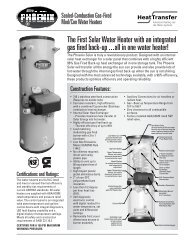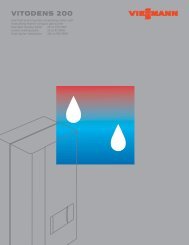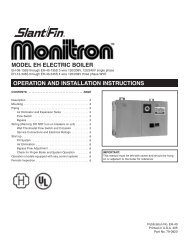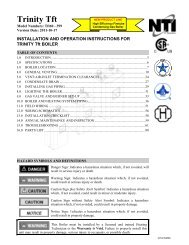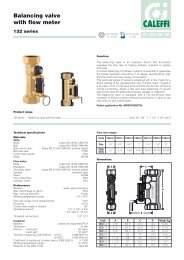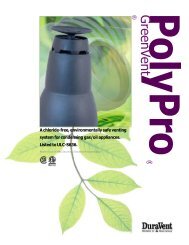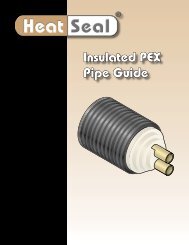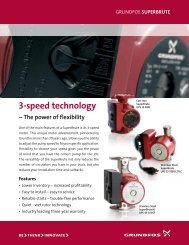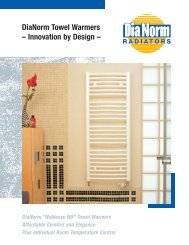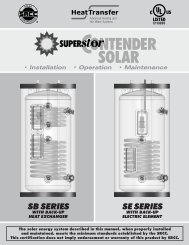Apricus Solar Water Heating System Installation and Operation ...
Apricus Solar Water Heating System Installation and Operation ...
Apricus Solar Water Heating System Installation and Operation ...
Create successful ePaper yourself
Turn your PDF publications into a flip-book with our unique Google optimized e-Paper software.
<strong>Apricus</strong> <strong>Solar</strong> Collector <strong>Installation</strong> & <strong>Operation</strong> Manual - USAc) Wall Strength: Always consider the weight of the collector<strong>and</strong> the structural integrity of the wall. If the wall constructionis not suitable for the load, it will be necessary to reinforcethe wall frame accordingly. Consult a building engineer fordesign requirements.d) Recommended Angle: Ideally, do not install the collectorbeyond an angle of 80° (close to vertical) otherwise heat pipeoperation will be impaired by 10% or greater. Installingvertically is permitted <strong>and</strong> will not void the warranty, butperformance will be reduced.e) Roof Eves: When installing on a wall, consider thepossible shading from eves, particularly in the summer(Unless this is part of the system design, in order to minimizesummer heat output). Installing under an eve overhang alsominimizes snow buildup on the collector in areas with regular, heavy snowfall.f) Safety Considerations: If installing the collector on a wall above a walkway,keep in mind the danger ofbroken glass that could fall on passersby, if the tubes were ever damaged. (E.g. during an extreme stormdue to flying debris or tree branch falling on the collector). It may be necessary for a barrier of to beinstalled below the collector to catch any falling materials, such as a clear roofing material.WARNINGIf the solar collector is installed above an area where people may walk, take appropriatemeasures to minimize the risk of injury, if a tube ever broke <strong>and</strong> glass fell onto the groundor people below.5.6. Connection to Plumbing5.6.1. Plumbing Connectiona) Once the frame has been mounted <strong>and</strong> the manifold attached, the manifold header may be connected tothe system plumbing.b) Delayed Commissioning: If the collector is to be installed (including evacuated tubes) prior to plumbingconnection (e.g. on new house), high temperature resistant covers (aluminum foil) should be placed overthe header inlet <strong>and</strong> outlet to prevent any contaminants (bugs, spiders, leaves, dust) entering the header.The solar collector will not be damaged by a short period of dry stagnation (1-2 weeks), however leaving thesolar collector exposed to the sun <strong>and</strong> not commission for extended periods will void the warranty.c) Soldering: The header connection is st<strong>and</strong>ard 3/4” (7/8” OD) copper pipe size <strong>and</strong> must be connected bysoldering using 90/5/5 (tin/silver/antimony) or equivalent lead free solder. Maximum allowable lead contentin solder for contact with potable water is normally 0.2% (or as specified by local plumbing code). In additiononly use solder that is able to withst<strong>and</strong> temperature of at least 482°F (250°C) without softening.When soldering, care must be taken to avoid exposing the manifold casing to the torch flame. Place a wetcotton cloth around the base of the header pipe to reduce at the silicone rubber seal. Point the flame awayfrom the collector <strong>and</strong> anything flammable while soldering. Take care not to set the wet rag on fire. It isadvisable to purchase a pocket fire extinguisher <strong>and</strong> keep it h<strong>and</strong>y while soldering.! Damage to collectors <strong>and</strong> other components incurred by extended dry or wet stagnation will not be eligible forwarranty claims.5.6.2. <strong>System</strong> High-Point Air Purgea) In order to completely purge the air from direct flow <strong>and</strong> closed loop systems, a Tee fitting must beinstalled at the high point in the system. Usually, this Tee can be soldered direction on the collector outlet(hot), instead of just a 90 elbow. The Tee side-connect (bull, arm) will then be on the collector header pipe,the lower Tee connect (pass-thru, run) on the Return Line <strong>and</strong> a ball valve can be then be installed on theuppermost Tee connect (pass-thru, run). On the top side of the ball valve, an automatic air vent should beCopyright 2011 – <strong>Apricus</strong> Inc Doc: A7-05.4.1.4-PB-1.9 Page 48 of 126



